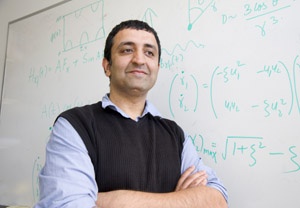May 7 2009
For Navin Khaneja, spinning nuclei are like atomic spies. With a little coaxing, they will tell the secrets of the molecules in which they sit.
 Navin Khaneja of the School of Engineering and Applied Sciences conducts research into the field of control theory, which uses mathematical models to examine the relationship between inputs and outputs of different systems. Jon Chase/Harvard News Office
Navin Khaneja of the School of Engineering and Applied Sciences conducts research into the field of control theory, which uses mathematical models to examine the relationship between inputs and outputs of different systems. Jon Chase/Harvard News Office
Khaneja, the Gordon McKay Professor of Electrical Engineering at the School of Engineering and Applied Sciences at Harvard University, conducts research into the field of control theory, which uses mathematical models to examine the relationship between inputs and outputs of different systems.
His current work focuses on nuclear magnetic resonance (NMR) spectroscopy, a technique that is used by chemists to understand the properties of molecules. As a mathematician and an engineer, Khaneja is working on new dynamical equations and novel ways to control their evolution that can guide the use of spectroscopy to understand molecular structure.
NMR spectroscopy depends on the fact that many atomic nuclei have a spin and an internal magnetism that responds to magnetic fields. Using strong magnetic fields and radio waves that function as probes, researchers poke at the nuclei and observe what happens.
NMR spectroscopists carefully observe the response of the nuclei when they’re probed, comparing them to other nuclei at different locations on the molecule. They look for variations that will reveal things about where the atom is located and which nearby atoms might be influencing its behavior. Much of Khaneja’s work today focuses on further development of these techniques, making them more accurate, sensitive, and robust to experimental errors.
Gerhard Wagner, Elkan Blout Professor of Biological Chemistry and Molecular Pharmacology at Harvard Medical School, is a frequent collaborator with Khaneja. Wagner’s research group runs a nuclear magnetic resonance laboratory and works with Khaneja to fine-tune the radio frequency pulses that probe the nuclei. The sequences devised by Khaneja can vary the frequency, phase, length, bandwidth, and amplitude of the pulses.
“There is a myriad of different pulse sequences. The common pulse sequences are designed according to basic physical principles and are used for our experiments to determine protein structures,” Wagner said. “However, there are good reasons to believe that more sophisticated pulse sequences could enhance the performance quite significantly. This cannot be done by intuition anymore, and a more systematic approach is desirable. This is where Navin comes in.”
Another of Khaneja’s research projects involves design of waveforms and pulse sequences for radar.
“By processing the returns from a diverse set of transmitted waveforms, it is possible to better estimate the position and velocity of moving targets. It is another example where intelligent probing is important,” Khaneja said.
Khaneja grew up in Faridabad, India, a town south of New Delhi. His father was an engineer at the local power generating station, and Khaneja still remembers visiting the plant and seeing the generators, boilers, and other components.
“From very early on, I decided I wanted to do engineering,” Khaneja said.
He studied at the Indian Institute of Technology in Kanpur, a school modeled on the Massachusetts Institute of Technology. After graduating with a bachelor’s degree in electrical engineering in 1994, he studied at Washington University in St. Louis, earning master’s degrees in mathematics and electrical engineering. It was there that he began working on control theory problems — trying to decipher the elements of vision to be applied in “seeing” computers.
He did his doctoral work at Harvard, earning a degree in applied mathematics in 2000. One section of his dissertation dealt with optimal control.
After graduating, he went to Dartmouth College, where he was an assistant professor of mathematics for a year. He joined Harvard’s faculty in July 2001 as an assistant professor of electrical engineering, was promoted to associate professor in 2005, and was named Gordon McKay Professor of Electrical Engineering in July 2008.
Khaneja teaches one class per semester. In the fall, it is a graduate course on control theory, and in the spring it is on probability and random processes. His classes, he said, help keep him grounded in the mainstream of the control theory community, since his research is quite specialized. One thing he likes about the control problems in spectroscopy is that at its more basic level it’s very accessible to students.
Khaneja said he thinks each year that he may finish his work on NMR spectroscopy, but he keeps finding new problems to solve.
“I’m doing this and at the same time learning it, which keeps it very interesting,” Khaneja said.